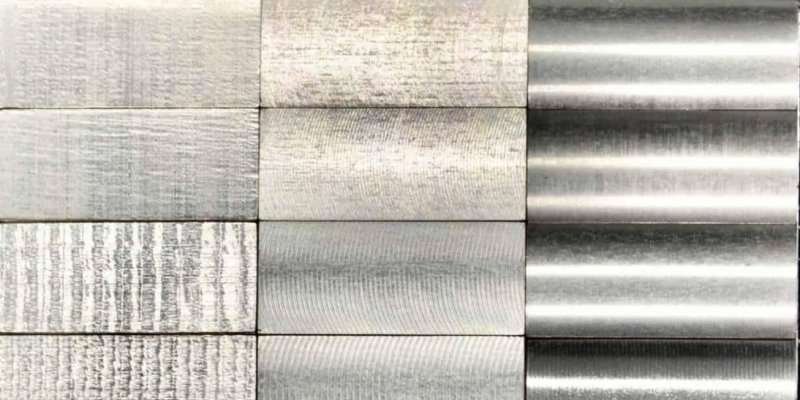Machinists often have to perform surface finishing operations after manufacturing parts and metal components. These finishes help to enhance the appearance, texture, and aesthetic appeal of the manufactured parts.
Brushing is the common surface finish. It involves using an abrasive brush to enhance the metal surfaces. Beyond improved aesthetics, it also helps improve the mechanical properties of the finished parts. This article provides all the details you need to understand about this precision finish.
What is Brushing in Finishing?
Brushing refers to the post-processing operations that involve using abrasive brushes to enhance the surface appearance and texture of metal surfaces. The finish creates a uniform parallel line on the metal surface, imparting a unique aesthetic quality.
Brushing also aids in riding the surface roughness, and burrs, among other imperfections obtained during the parts manufacture. Moreover, it enhances grip, and adhesion, improving the physical and mechanical features of the metal component.
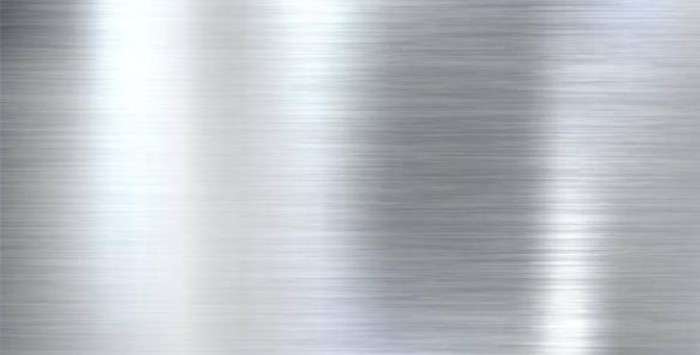
Steps in Brushing a Metal Surface
The brushing process employs grain abrasive brushes to enhance the surface properties of metal surfaces. It involves gently rolling and pressing the brush’s abrasive filaments, usually against the metal surface. This process removes contours and other imperfections, creating a more rounded edge.
Achieving a high-quality brushed finish involves adhering to the three main stages involved in this surface finish.
1. Pre-Brushing
As the name suggests, this includes a series of activities you engage in before the actual metal brushing. The first step is surface cleaning, which helps prepare the metal surface and rids it of contaminants, grease, dirt, etc. After cleaning, you can use sandpaper to sand the metal to remove scratches and other machining defects.
2. Brushing
After cleaning and preparing the metal, you can begin the actual brushing process. Brushing involves moving an abrasive bush in a rotatory motion on the metal surface. As the brush moves over the metal surface, it removes blemishes, imperfections, and other defects. Also, it creates fine lines on the metal surface, giving it a unique brushed finish.
Generally, maintaining a particular brushing direction is crucial for achieving a consistent finish. That said, ensure to control the pressure you apply on the brush and the wheel speed. This helps you achieve your desired depth and texture of the brushed finish.
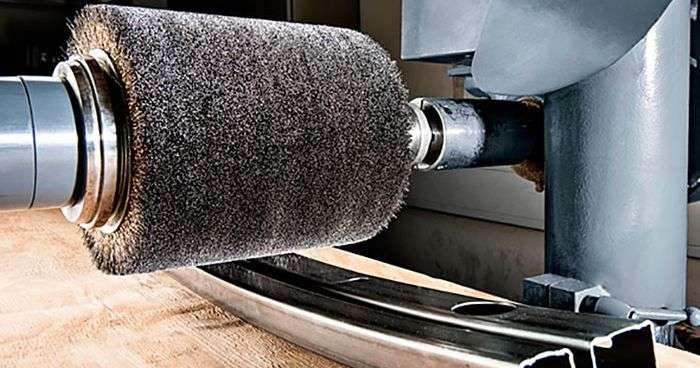
3. Post-Brushing
After brushing, you may still perform some processes to optimize the final product further. This involves rinsing the metal in water tanks containing purifying solvents such as alkalis, surfactants, or acids. You may also use a suitable polish to enhance the metal surface further.
In fact, brushing is not usually the last surface finishing process. It’s often used as an intermediary finish for other finishes like polishing, painting, powder coating, or electroplating.
Advantages and Limitations of Brushed Finishing
Brushed finishing enhances the physical and mechanical features of your machined parts. However, it also has some shortcomings. Let’s take a quick look at the advantages and the cons.
Advantages
- Enhances appearance and aesthetic appeal;
- Improves parts durability;
- Promotes better adhesion to paints and other adhesives;
- Hides scratches, blemishes, and other defects;
- Enhances corrosion and chemical resistance;
- It maintains the part’s tolerance and dimensional accuracy.
Limitations
- The brushed finish may leave brush marks, especially if it’s too dense;
- Achieving surface uniformity may be challenging;
- Sometimes, brushed surfaces are difficult to clean.
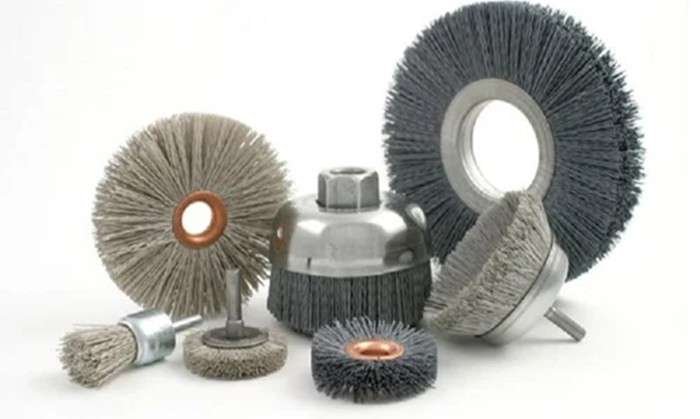
Types of Brushes for Surface Finishes
Brushes for brushing metal surfaces are usually made of abrasive materials, often wires. These tools differ in length, fill density, and material type, allowing the creation of a consistent satin-like surface finish upon proper application. The two standard brush types used in brushed metal finish include the following.
Steel Wire Brushes
Steel wire brushes are typical for achieving a brushed metal surface finish. It’s a common choice for brushing because it maintains the parts’ tolerance and dimensional accuracy. These brushes are suitable for brushing various metal surfaces. However, it’s the only kind applicable to brushed stainless steel. Note that these tips often come in different styles and configurations, depending on the goal or application of the finishing.
For example, steel wire brushes with short filaments tend to move rapidly, supporting vast applications, while those with more extended tips are better suited for controlled brushing of contoured faces. As briefly mentioned, the wires may also differ in their fill density. The short-trim, high-density brushes afford swift brushing and is usually more durable. However, the low-dense brush affords better flexibility.
Furthermore, unlike typical brushes, these steel wire brushes are non-loading. That is, they do not accumulate the debris and contaminants they brush off on metal surfaces.
Power Brushes
A typical power brush has its abrasive components made from carbon steel, ferrous and non-ferrous wires, or fibers that are either natural or synthetic. Like steel wire brushes, they also provide extensive surface finish applications.
Power brushes are often grouped based on the pressure you must apply to achieve a particular finish. However, the filament length, fill density, and the surface of the workpiece also determine the kind of finish you’d obtain. The machinists must understand when to modify these parameters to achieve a high-quality, desirable finish.
For example, when looking to achieve an intensive, finer finish, the trim length must be short, with an increased fill density moving at slow speeds. On the other hand, longer abrasive filaments achieve faster speeds but milder finishing and less dense filling.
In addition, beyond the typical finishes – polishing, edge finishing, etc., power brushes are suitable for improving the mechanical and physical resistance of metal fabrications. They also help get rid of contaminants and rust from metal surfaces.
Mechanical Applications of Brushed Finish
A brushed finish, like any other surface finishing procedure, is performed to enhance the general properties of a manufactured part. Below are more specific applications of brushed finishing.
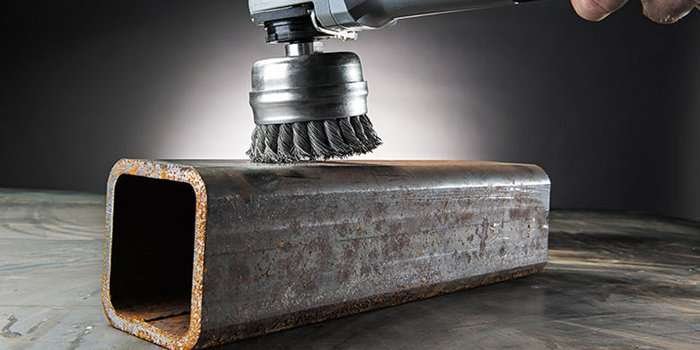
Cleaning
A brushed finish allows the creation of fine parallel lines on the surface of machined parts. The finish allows easy removal and prevents the accumulation of dirt, rust, slags, grime, film, and other contaminants.
Deburring
The brushes used in this finishing help rid burrs and other imperfections of metal surfaces. The metal surfaces get smoothened during brushing, yielding smooth edges with fewer protrusions or burrs.
Roughening
Beyond producing smooth, shiny surfaces, a brushing finish may also help to roughen metal surfaces. This application is most important for achieving better surface adhesion, especially before other surface finishing like painting. Metal surfaces roughened with steel wire or power brush possess better adhesive properties.
Edge Blending
After machining, the edges of the workpiece may be too sharp, hence the need to blend and smoothen such edges. Brushing, especially with a power brush, helps create less sharp and rounded edges. It promotes a better transition between where two surfaces meet – the edge. Also, it does not alter the part’s tolerance or affect the dimensional accuracy.
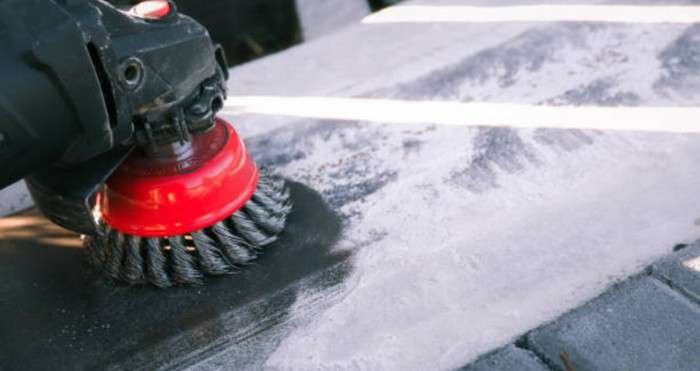
Factors and Tips to Determine the Quality of a Brushed Finishing
Indeed, the choice of brush and technique plays a crucial role in the finishing you obtain. However, other factors may affect your brushed finishing. As a machinist, you must understand these tips to achieve your intended finish.
Brush Types
The choice of brush type plays a crucial role in achieving your desired brushed finish. For example, whether you intend to clean, deburr, or roughen the surface, the kind of brush you select determines the texture and effects you achieve.
Also, the material you are working too will affect your brush choice. For example, you can only use a steel brush when working with stainless steel. Moreover, ensure that the brush you select adheres to your fabrication’s specified requirements. Beyond the type of brush, ensure to use a high-quality brush to produce a durable finish.
Brushing Direction
The direction in which the machinist brushes plays a significant role in the outcome of the finishing process. Maintaining consistency in the brushing direction helps to avoid brushing irregularities and maintain a suitable aesthetic appealing surface finish.
In the past, a typical brushed finish created unidirectional lines parallel to the motion of the brush. However, machinists are taking a new route. Experts advise against brushing along the brush’s movement, as it may cause the brush’s top to become dull after extended use, making the process less efficient. Consequently, you should create the brush lines opposite the brushing motion.
Wheel Speeding
The wheel of the brush refers to the rotating tool used in brushing. That said, the speed of the brushing wheel plays a crucial role in the kind of finish you achieve. Generally, brushing with high wheel speed gives the best outcome. However, it could cause heat build-up or even burn out metal surfaces. Moreover, it could even cause the quick bending of the brush filaments.
Manufacturers must know the limits of the wheel speed of their brush to prevent brushing defects. It’s best to brush below the speed limit – the maximum revolution per minute of the brush or the top safe speed.
Moreover, modulating the wheel speed is essential for customizing the brushed finish to fit your fabrication specifications. Gaining mastery of the wheel speed of your brush helps you achieve better precision and dimensional accuracy.
Level of Operator’s Expertise
Beyond all the factors discussed, the machinist’s skill level also comes into play when brushing. The quality of the finished part depends on the operator’s expertise and how they handle the finishing process.
In fact, a skilled technician understands the intricacies of selecting the right brush, optimizing the wheel speed, and brushing directions, among other nuances, to achieve a top-notch brushed finish.
Comparing Brushed Finishing to Other Surface Finishing
How does a brushed finish compare to other standard metal surface finishing? Let’s compare this finishing to two different typical surface finishes.
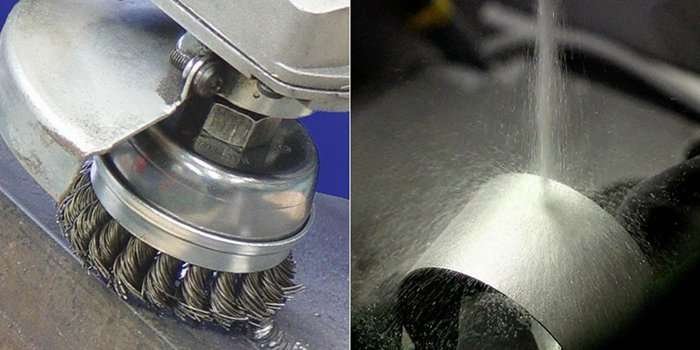
Brushed Finish vs. Bead Blasting
Both finishes involve using an abrasive tool on a metal surface. While brushed finishing involves cleaning and ridding the metal surfaces of blemishes and imperfections, bead blasting obscures or coats the metal’s original surface with specific beads. The process involves blasting the metal surface with abrasive particles, the beads. They are usually made of ceramics, glass, metal, or corundum.
The finish creates a uniform, homogenous matte texture with little reflectivity. In addition, while a brushed finish often forms parallel, unidirectional lines on the metal surfaces, the bead blasting procedure is usually non-directional.
Brushed Finish vs. Satin Finish
Again, both finishes share some similarities. In fact, they are more similar, with people using them interchangeably, because they both leave the metal surfaces with little shiny and reflective properties.
However, a satin finish often uses a sanding (or abrasive) process, providing a glossier finish than an abrasive brush in a brushed finish. Also, the satin metal surface has little to no lines, so they are usually smoother with a more consistent texture. That said, while brushing is restricted to using an abrasive brush, a satin finish may employ other abrasive materials, like sand or paper.
Furthermore, a satin finish tends to have more mechanical and chemical resistance, making it suitable as a final finish, unlike brushed finishing.
XinCheng Offers Metal Finishing Operations for Your Projects
It’s good to understand the brush finishing operation for your fabrication. However, partnering with a reputable company helps you achieve a top-notch fabrication that meets all your requirements.
XinCheng is the partner you need for your metal finishing processes. We deliver high-quality operations, irrespective of tight tolerance and high precision specification. In addition, we offer industry-standard CNC machining services, sheet metal fabrication, surface finishing, and other related manufacturing services at competitive prices. Contact us today and get a free quote!
Conclusion
While brushing operations are often the final post-processing operation, they help enhance the general features of the machined parts. Also, it’s a valuable surface finishing process, as it maintains the dimensional accuracy and precision of the manufactured parts. That said, it’s a crucial process you should perform before finally applying other finishes like plating and painting.
FAQs
What material is brushed finish?
A brushed finish is suitable for various materials, especially metals. Typical brushing operations include a brushed aluminum finish. It also suits other metals and alloys like stainless steel, bronze, and brass.
Is brushed finish the same as matte?
No, a brushed finish differs from a matte finish. However, both processes result in metal surfaces with a non-reflective appearance. In addition, a brushed finish creates parallel lines from the brush, while a matte finish is often more consistent and uniform.
Which type of brush is the best for a brushed finish?
The type of brush for a brushed finish depends on the intended texture and depth of the finish. For example, when looking to achieve a fine texture, you should use a softer brush. However, use a coarse brush for a more pronounced or profound texture.

